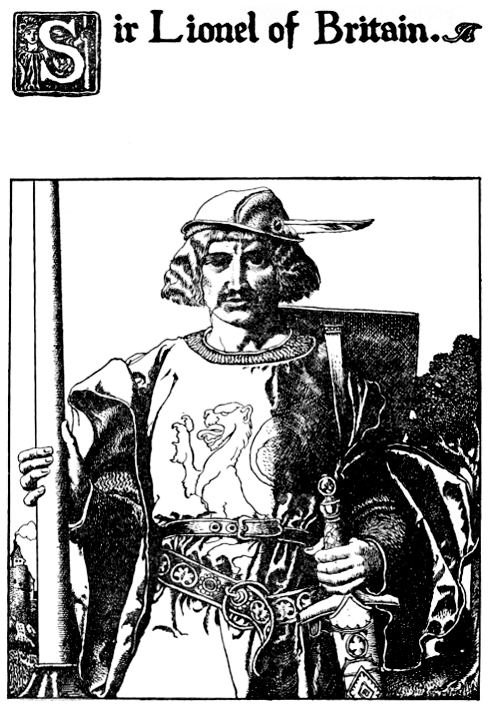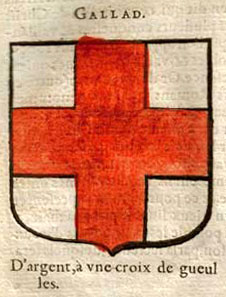|
Bors
Bors (; french: link=no, Bohort) is the name of two knights in Arthurian legend, an elder and a younger. The two first appear in the 13th-century Lancelot-Grail romance prose cycle. Bors the Elder is the King of Gaunnes (Gannes/Gaunes/Ganis) during the early period of King Arthur's reign, and is the brother of King Ban of Benoic and the father of Bors the Younger and Lionel. His son Bors the Younger later becomes one of the best Knights of the Round Table and participates in the achievement of the Holy Grail. King Bors the Elder Bors the Elder is King Ban's brother, and Lancelot's and Hector de Maris' uncle. He marries Evaine, the sister of Ban's wife Elaine, and has two sons, Bors the Younger and Lionel. Ban and Bors become Arthur's early allies in his fight against eleven rebel kings in Britain, including Lot, Urien, and Caradoc, In return, Arthur vows to help them against their Frankish enemy, King Claudas, who has been threatening their lands back in the ... [...More Info...] [...Related Items...] OR: [Wikipedia] [Google] [Baidu] |
Sir Bors De Ganis
Bors (; french: link=no, Bohort) is the name of two knights in Arthurian legend, an elder and a younger. The two first appear in the 13th-century Lancelot-Grail romance prose cycle. Bors the Elder is the King of Gaunnes (Gannes/Gaunes/Ganis) during the early period of King Arthur's reign, and is the brother of King Ban of Benoic and the father of Bors the Younger and Lionel. His son Bors the Younger later becomes one of the best Knights of the Round Table and participates in the achievement of the Holy Grail. King Bors the Elder Bors the Elder is King Ban's brother, and Lancelot's and Hector de Maris' uncle. He marries Evaine, the sister of Ban's wife Elaine, and has two sons, Bors the Younger and Lionel. Ban and Bors become Arthur's early allies in his fight against eleven rebel kings in Britain, including Lot, Urien, and Caradoc, In return, Arthur vows to help them against their Frankish enemy, King Claudas, who has been threatening their lands back in the continent. ... [...More Info...] [...Related Items...] OR: [Wikipedia] [Google] [Baidu] |
Knights Of The Round Table
The Knights of the Round Table ( cy, Marchogion y Ford Gron, kw, Marghekyon an Moos Krenn, br, Marc'hegien an Daol Grenn) are the knights of the fellowship of King Arthur in the literary cycle of the Matter of Britain. First appearing in literature in the mid-12th century, the Knights are an order dedicated to ensuring the peace of Arthur's kingdom following an early warring period, entrusted in later years to undergo a mystical quest for the Holy Grail. The Round Table at which they meet is a symbol of the equality of its members, who range from sovereign royals to minor nobles. The various stories in the cycle present an assortment of knights from all over Great Britain and abroad, some of whom are even from outside of Europe. Their ranks often include Arthur's close and distant relatives, such as Agravain and Gaheris, as well as his reconciled enemies and those he defeated in battle, including Galehaut and Lot. Several of the most notable knights, including Bediver ... [...More Info...] [...Related Items...] OR: [Wikipedia] [Google] [Baidu] |
Claudas
King Claudas is a fictional king who is an opponent to King Arthur, Lancelot, and Bors in Arthurian literature. His kingdom is situated in the Berry and is named "Terre Deserte", or "Land Laid Waste", so called because of the destruction Uther Pendragon had wrought there. Claudas appears as the Round Table's adversary in ''Perlesvaus'', the Vulgate and Post-Vulgate Cycles, and Malory's '' Le Morte d'Arthur''. He wages war on Kings Ban and Bors in the early period of Arthur's reign, and succeeds in conquering many of their lands. Ban and Bors help Arthur in his conflicts against rebellious kings in Britain, but Arthur is unable to send them reinforcements to deal with Claudas. Bors dies fighting against Claudas, who takes in his sons Bors the Younger and Lionel and has them raised as prisoners in his court. When Ban dies, his son Lancelot is swept away by the Lady of the Lake to be raised in her underwater palace. Arthur pursues a truce with Claudas that lasts some time. Whe ... [...More Info...] [...Related Items...] OR: [Wikipedia] [Google] [Baidu] |
Sir Lionel
Sir Lionel is the younger son of King Bors of Gaunnes (or Gaul) and Evaine and brother of Bors the Younger in Arthurian legend since the Lancelot-Grail cycle. He is a double cousin of Lancelot and cousin of Lancelot's younger half-brother Hector de Maris (not to be confused with the older Sir Ector, who was King Arthur's foster-father). He later became the subject of one of the famous Child Ballads (# 18). Arthurian legend When their father dies in battle against King Claudas, Lionel and Bors are rescued by the Lady of the Lake and raised in her otherworldly kingdom alongside her foster-son Lancelot. Like Bors and Lancelot, Lionel becomes a Knight of the Round Table upon reaching the age and then proving himself in heroic deeds. One day, while travelling with Lancelot as a young man, Lionel is captured by the rogue knight Turquine, who whips him with briars and throws him in the dungeon. The scenario repeats itself later while he is on the Quest for the Holy Grail, ... [...More Info...] [...Related Items...] OR: [Wikipedia] [Google] [Baidu] |
Lancelot
Lancelot du Lac (French for Lancelot of the Lake), also written as Launcelot and other variants (such as early German ''Lanzelet'', early French ''Lanselos'', early Welsh ''Lanslod Lak'', Italian ''Lancillotto'', Spanish ''Lanzarote del Lago'', and Welsh ''Lawnslot y Llyn''), is a character in some versions of Arthurian legend, where he is typically depicted as King Arthur's close companion and one of the greatest Knights of the Round Table. In the French-inspired Arthurian chivalric romance tradition, Lancelot is an orphaned son of King Ban of the lost Kingdom of Benoic, raised in the fairy realm by the Lady of the Lake. A hero of many battles, quests and tournaments, and famed as a nearly unrivalled swordsman and jouster, Lancelot becomes the lord of the castle Joyous Gard and personal champion of Arthur's wife, Queen Guinevere, despite suffering from frequent and sometimes prolonged fits of madness. But when his adulterous affair with Guinevere is discovered, it ca ... [...More Info...] [...Related Items...] OR: [Wikipedia] [Google] [Baidu] |
King Ban
Ban is the King of Benwick or Benoic in Arthurian legend. First appearing by this name in the ''Lancelot propre'' part of the Vulgate Cycle, he is the father of Sir Lancelot and Sir Hector de Maris, and is the brother of King Bors. Ban largely corresponds to the other versions of the father of Lancelot, including Pant of Gen wis in ''Lanzelet'', Haud of Schuwake in the English ballad '' Sir Lancelot du Lake'', and Domolot of Lokva in '. Role in Arthurian romances Ban's wife Elaine is the sister to King Bors' wife Evaine. Together they beget Lancelot, but while travelling in Britain in support of King Arthur, Ban sleeps with the Lady de Maris, who becomes pregnant with Hector de Maris, Lancelot's half-brother. Ban and Bors are eventually killed by their enemy, the Frankish king Claudas, and Lancelot is taken by the Lady of the Lake to her abode, where he is later joined by Bors the Elder's sons Lionel and Bors the Younger. When the children grow up and become Knights of ... [...More Info...] [...Related Items...] OR: [Wikipedia] [Google] [Baidu] |
Galahad
Sir Galahad (), sometimes referred to as Galeas () or Galath (), among other versions of his name, is a knight of King Arthur's Round Table and one of the three achievers of the Holy Grail in Arthurian legend. He is the illegitimate son of Sir Lancelot du Lac and Lady Elaine of Corbenic and is renowned for his gallantry and purity as the most perfect of all knights. Emerging quite late in the medieval Arthurian tradition, Sir Galahad first appears in the Lancelot–Grail cycle, and his story is taken up in later works, such as the Post-Vulgate Cycle, and Sir Thomas Malory's '' Le Morte d'Arthur''. Origins The story of Galahad and his quest for the Holy Grail is a relatively late addition to the Arthurian legend. Galahad does not feature in any romance by Chrétien de Troyes, or in Robert de Boron's Grail stories, or in any of the continuations of Chrétien's story of the mysterious castle of the Fisher King. He first appears in a 13th-century Old French Arthurian epic, t ... [...More Info...] [...Related Items...] OR: [Wikipedia] [Google] [Baidu] |
Lancelot-Grail
The ''Lancelot-Grail'', also known as the Vulgate Cycle or the Pseudo-Map Cycle, is an early 13th-century French Arthurian literary cycle consisting of interconnected prose episodes of chivalric romance in Old French. The cycle of unknown authorship, presenting itself as a chronicle of actual events, retells the legend of King Arthur by focusing on the love affair between Lancelot and Guinevere as well as the religious quest for the Holy Grail, expanding on the works of Robert de Boron and Chrétien de Troyes. There is no unity of place, but most of the episodes take place in Arthur's kingdom of Logres. One of the main characters is Arthur himself, around whom gravitates a host of other heroes, many of whom are Knights of the Round Table. Among them is the famed Lancelot, whose chivalric tale is centered around his illicit romance with Arthur's wife, Queen Guinevere. However, the cycle also tells of adventures of a more spiritual type; those involve the Holy Grail, the vesse ... [...More Info...] [...Related Items...] OR: [Wikipedia] [Google] [Baidu] |






_Biblioteca_Nazionale_Centrale_di_Firenze.jpg)